Elon Musk’s $6,759 Tesla Tiny House Finally Hits the Market — and It Could Change the Way the World Lives
In a surprise move that has both Tesla fans and housing futurists buzzing, Elon Musk’s long-rumored Tesla Tiny House has officially arrived on the market — and its shockingly low price tag of just $6,759 is making people question everything they thought they knew about home ownership.
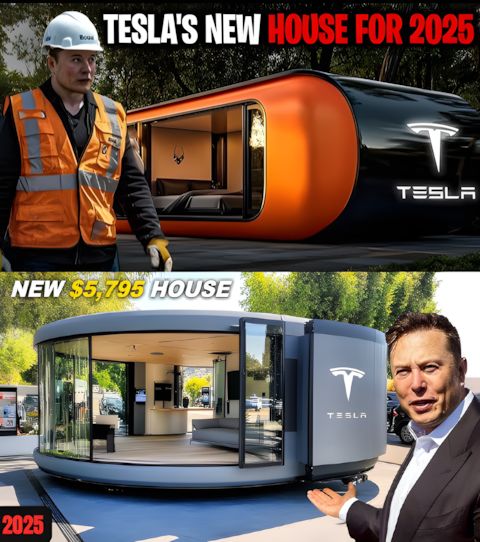
What seems like science fiction is suddenly reality: a sleek, sustainable, tech-powered micro-home engineered by one of the most disruptive minds on the planet. And if the early hype is anything to go by, the Tesla Tiny House isn’t just a bold experiment — it could be the beginning of a housing revolution.
A Glimpse Into the Future: What Is the Tesla Tiny House?
Measuring just under 400 square feet, the Tesla Tiny House is a compact, minimalist living space that integrates Tesla’s core technologies in solar energy, energy storage, smart automation, and sustainable materials. Built almost entirely from recycled and renewable materials, the home is off-grid capable and fully self-sustaining.
The unit, internally codenamed Project NestBox, has been quietly developed in Tesla’s Nevada R&D lab in partnership with SpaceX engineers, who brought their experience in closed-loop life-support systems to the project. In a way, this house is a terrestrial echo of Martian design principles — small, efficient, independent, and built to thrive in harsh environments.
What’s Inside? Surprisingly, Everything You Need
At first glance, the house resembles a modernist cube with sleek black solar panels lining the exterior, clean white walls, and a bold red Tesla “T” discreetly embossed near the doorway. But step inside, and the brilliance of its design becomes immediately clear.
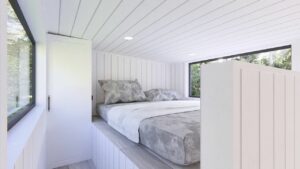
✦ Living Space
A transformable modular space that shifts from living room to bedroom to workspace using AI-assisted robotics. Furniture folds into walls. A hidden Murphy bed glides down silently with a gesture. LED lighting adjusts to circadian rhythms automatically.
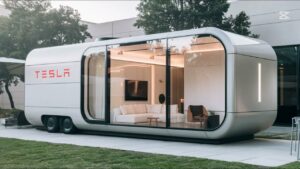
✦ Kitchen
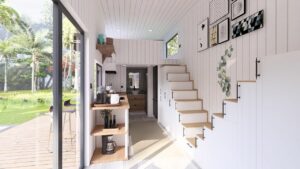
Outfitted with an induction cooktop, smart sink, micro-dishwasher, and a compact refrigerator, all powered via Tesla Powerwall and regulated by Tesla HomeOS, a new software platform derived from the Tesla car interface.
✦ Bathroom
The bathroom features a graywater recycling system, a vacuum-sealed composting toilet, and a smart shower that uses 47% less water without compromising pressure — ideal for both off-grid life and urban water-saving.
✦ Solar and Storage
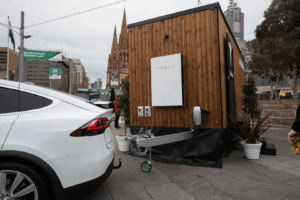
The roof is a seamless slab of Tesla Solar Glass, capable of generating enough electricity to power the entire house, even in low-sunlight environments. The energy is stored in a next-generation Powerwall Ultra, which can run the house for 5 days without sunlight.
✦ Connectivity and AI
Fully 5G-connected (with Starlink compatibility for remote areas), the house features voice-controlled automation, adaptive environmental controls, and integrated biometric locks. Even the windows tint automatically based on sunlight and temperature.
Who Is This For? Everyone. That’s the Point.
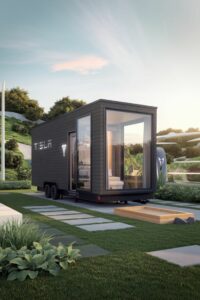
Elon Musk has never been shy about his ambitions to make the future accessible to everyone. With the Tesla Tiny House, that ambition enters the realm of basic human needs: shelter. According to internal documents leaked earlier this year, the house is intended for:
-
Urban dwellers looking to downsize without sacrificing tech comforts
-
Off-grid enthusiasts wanting a low-footprint, self-powered lifestyle
-
Disaster recovery zones needing fast, scalable, livable shelter
-
Space colonization simulations, particularly for Mars base testing in Boca Chica
Even Musk himself is rumored to be living in a prototype unit located near SpaceX’s Starbase in Texas, further fueling speculation that this project is a test case for interplanetary habitats.
Tesla’s Vision for a Modular Living Ecosystem
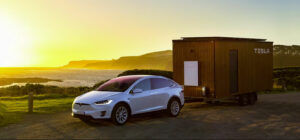
Perhaps the most radical part of this project isn’t the house itself, but the vision behind it. Tesla’s long-term plan, as revealed in a confidential investor briefing, includes the ability to link multiple units together like digital Lego bricks — creating modular communities that are energy-independent, reconfigurable, and transportable by electric truck or drone.
Tesla is also reportedly working on a “Plug & Play Land Pack” — a smart plot of land embedded with inductive charging coils, rainwater harvesting, and autonomous gardening systems, which a tiny house can simply “drop onto” and start living.
Imagine neighborhoods with no power lines, no water bills, and no carbon footprint — just rows of beautiful, self-sustaining homes powered by the sun and backed by AI.
The Price? Real. And It’s Causing a Stir
The most unbelievable part? The price: $6,759. While add-ons like enhanced solar storage, extra automation, or luxury interiors can increase the total cost, the base unit remains within reach for millions of people. Musk claims this is made possible by:
-
3D printed components
-
AI-optimized supply chain logistics
-
Recycled aerospace-grade materials
-
Direct-to-consumer production pipeline
Tesla is reportedly accepting pre-orders now via a limited pilot program, with deliveries expected to begin in late 2025.
Critics Call It a Gimmick — But the Demand Says Otherwise
Skeptics argue the house is too small, too futuristic, too experimental. But the waiting list is already tens of thousands deep, with influencers, climate activists, and forward-thinking architects all praising the project as a “leap forward in democratic design.”
A New Era in Human Habitat?
Whether it becomes a niche product or a world-changing solution, one thing is clear: the Tesla Tiny House is a statement. A declaration that sustainability, affordability, and elegance don’t have to be mutually exclusive. That the home of the future can be compact, mobile, intelligent—and still feel like home.
As Elon Musk himself posted on X:
“You don’t need a mansion to live like a billionaire. You need a brain and a battery.”